My maternal great-grandparents purchased a cabin on Newman Lake, Washington from its original owner/builder in 1937. Nine years later, it was sold by them to their son and his wife – my grandparents Boyd and Jerene McDowell. A little over thirty years ago, I inherited this cabin from them. Having grown up spending most of my summers there, I envisioned turning this cabin into a year-around home.
This cabin’s original hand split cedar shake roofing (on a 7/12 slope over 1x skip sheeting) had been replaced once, by my father – and we enjoyed using these original shingles as fire starter for many years. This second roof was then again replaced with Cocoa Brown polyester painted thru-screwed steel. Polyester paint, while certainly a step up from bare galvanized, did not maintain its original luster for long (for extended reading on Polyester paint: https://www.hansenpolebuildings.com/2014/05/polyester-paint/).
As my vision involved significant remodel work, we opted to change roofing to a SMP paint (https://www.hansenpolebuildings.com/2014/05/smp/) with an actual fade and chalk warranty. Through a series of events, our remodel schedule had to be moved forward from its originally intended Spring start, to doing work in Winter. Again (keep in mind), in Northeast Washington. Of course, as luck would have it, reroofing coincided with bitter cold and snow showers – resulting in speed of installation becoming of utmost importance. While I did much work myself, I had an assist from a casual labor wrangler appropriately known as “Big Kevin” who would round up day labor as needed. This reroof required some of these extra bodies.
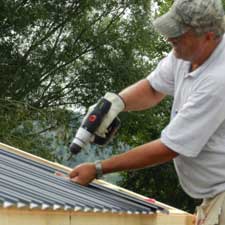 Fast forwarding a few years, I found some steel roof thru-screws were “backing out”. Upon careful examination, I found out why – in a hurry to get roofing installed, Big Kevin’s casual help had decided it would be quicker to pound screws in with a hammer (as could be evidenced by damage to screw heads)!
Fast forwarding a few years, I found some steel roof thru-screws were “backing out”. Upon careful examination, I found out why – in a hurry to get roofing installed, Big Kevin’s casual help had decided it would be quicker to pound screws in with a hammer (as could be evidenced by damage to screw heads)!
When screws are either over driven (or beat in by hammer), it damages wood fibers reducing or virtually eliminating their holding power. There was a solution – replacing these #9 diameter screws with larger #14 screws. These larger diameter screws, installed properly, were then able to get a firm bite into undamaged wood.
Using an actual screw gun (rather than a drill motor) with a clutch prevents most instances of over driving screws. Should a screw inadvertently be over driven, there is a quick field fix. All it takes is a short 2×4 and a table saw. Cutting with grain of wood, make a series of cuts in both directions to leave 1/8” squares remaining when looking at the 2×4 end. Turning to cut cross grain, chop these off in one-inch increments. This results in what appears to now be headless match sticks (albeit from much stronger lumber). Remove any offending screws and carefully drive a 1/8” square by an inch ‘plug’ into the screw hole in the underlying purlin. A screw can then be replaced into a plug filled hole, where it will happily remain in place.
Tag Archives: SMP Paint
Kynar Paint for Barndominiums
Many potential barndominium owners are looking to get the greatest value for their investment and many see this as their ‘forever’ home. If you fall into this category, I would highly recommend exploring Kynar® painted steel.
I could extol aesthetic reasons to use Kynar painted steel for longer than anyone would be willing to listen.
Polyvinylidene fluoride is acknowledged as the premium resin for coil coatings. Popularly known by its original trade name Kynar, PVDF is a kind of fluoropolymer, a family which includes Teflon and Halar. Key to these chemicals’ toughness is the bond between carbon and fluoride, the strongest possible polymeric connection.
PVDF resin has superior chalk resistance and gloss retention, as well as stain and chemical resistance. It is softer than SMPs and polyesters, however, making it highly formable without risk of cracking, but also relatively easy to scratch during transport or installation. PVDF is most durable when it makes up 70 percent of resin; higher concentrations do not coat well, since acrylic is important for dispersion during coating processes.
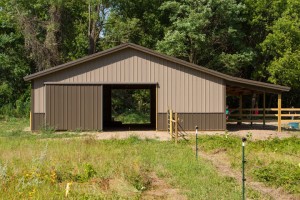 There are two general classes of pigments. Organic, or carbon-based, pigments are generally synthetic and relatively inexpensive to make. However, organics have fairly weak molecular bonds which are easily broken down by moisture, UV and pollutants, and so, are prone to fading. Inorganic pigments are those which do not contain carbon, and may be naturally occurring or manufactured. They generally offer good fade resistance, with an exception of carbon black. Many simple inorganics are metal oxides, such as widely used iron oxide and titanium dioxide.
There are two general classes of pigments. Organic, or carbon-based, pigments are generally synthetic and relatively inexpensive to make. However, organics have fairly weak molecular bonds which are easily broken down by moisture, UV and pollutants, and so, are prone to fading. Inorganic pigments are those which do not contain carbon, and may be naturally occurring or manufactured. They generally offer good fade resistance, with an exception of carbon black. Many simple inorganics are metal oxides, such as widely used iron oxide and titanium dioxide.
Kynar 500/Hylar 5000 systems, which are required to contain 70 percent PVDF, do not vary greatly between manufacturers. Since these paints carry 20- to 30- year warranties which allow for extremely little face, these companies all use ceramics and appropriate inorganic pigments.
One manufacturer we purchase Kynar 500 painted steel from is McElroy Metal. Here is a photo which really shows off performance differences between Kynar and SMP: http://www.mcelroymetal.com/elements/files/Kynar%20500%20VS.%20SP%20Flyer
Sadly, PVDF paints are not available nationwide. Personally – if available where I was planning to build and color choice was other than White, I would make an investment for better paint. I want my building to look as close to new as possible, for as long as I own it!
At NFBA’s (National Frame Building Association) 2019 Expo I cornered Sherwin-William’s representative for further information on Fluropon® (PVDF). Please enjoy this video:
https://drive.google.com/open?id=14fzlL1agiMOZ6Sq67ce6H5JrF9iSc1Kp
Skylights Leaking
Reader DIANA writes, ”skylights leaking in 40 year old barn. Is it possible to replace the sky lights with metal.”
Skylights in steel roofs are problematic, and not just due to them eventually leaking. You will certainly want to read this article: https://www.hansenpolebuildings.com/2016/01/one-more-reason-to-not-use-skylights-in-steel-roofs/.
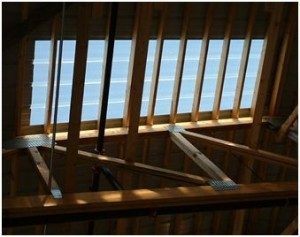 Now, considering your entire roof is 40 years old – it would be possible to replace only skylight panels. This would be providing rib configuration of steel can be matched. Over 40 years many patterns have been discontinued.
Now, considering your entire roof is 40 years old – it would be possible to replace only skylight panels. This would be providing rib configuration of steel can be matched. Over 40 years many patterns have been discontinued.
You asked for my expert opinion and I therefore take upon myself to answer as if it was my very own building. This isn’t about trying to make money (although some readers may become Hansen Pole Buildings’ clients following reading of a few of my articles), it is about people getting a great value for their building dollar. I’d be first to admit to it, if I did not believe our buildings are an example of best value.
If someone actually does happen to have a better value component, let me know and we will try to incorporate it and, if possible, improve upon it.
I’d look to replacing entire roof surface. Paint systems, such as Kynar (https://www.hansenpolebuildings.com/2014/05/kynar/), are available in most U.S. areas. There are also ‘Lifetime’ warrantees available on many SMP (https://www.hansenpolebuildings.com/2014/05/smp/) painted products.
Your existing roofing was probably installed using nails, rather than screws. It was industry standard then (read more here: https://www.hansenpolebuildings.com/2011/12/ring-shank-nails/). Ideally a new roof panel screw layout will be such as with some adjustment all existing nail holes can be missed.
I’d recommend using powder coated Diaphragm screws to attach roofing to underlying purlin framing. You can read why here: https://www.hansenpolebuildings.com/2012/08/this-is-a-test-steel-strength/.
Kynar®
One word says it all – Kynar®. I could extol the aesthetic reasons to use Kynar® painted steel for longer than anyone would be willing to listen.
Polyvinylidene fluoride is acknowledged as the premium resin for coil coatings. Popularly known by its original trade name Kynar®, is a PVDF resin-based coating or finish, a family which includes Teflon and Halar. Key to these chemicals’ toughness is the bond between carbon and fluoride, the strongest possible polymeric connection.
PVDF resin has superior chalk resistance and gloss retention, as well as stain and chemical resistance. It is softer than SMPs and polyesters, however, making it highly formable without risk of cracking, but also relatively easy to scratch during transport or installation. PVDF is most durable when it makes up 70 percent of the resin; higher concentrations do not coat well, since the acrylic is important for dispersion during the coating process.
There are two general classes of pigments. Organic, or carbon-based, pigments are generally synthetic and relatively inexpensive to make. However, organics have fairly weak molecular bonds which are easily broken down by moisture, UV and pollutants, and so are prone to fading. Inorganic pigments are those which do not contain carbon, and may be naturally occurring or manufactured. They generally offer good fade resistance, with the exception of carbon black. Many simple inorganics are metal oxides, such as the widely used iron oxide and titanium dioxide.
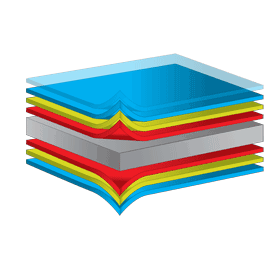 Kynar® 500/Hylar 5000 systems, which are required to contain 70 percent PVDF, do not vary greatly between manufacturers. Since the paints carry 20- to 30- year warranties which allow for extremely little face, the companies all use ceramics and appropriate inorganic pigments.
Kynar® 500/Hylar 5000 systems, which are required to contain 70 percent PVDF, do not vary greatly between manufacturers. Since the paints carry 20- to 30- year warranties which allow for extremely little face, the companies all use ceramics and appropriate inorganic pigments.
One of the manufacturers we purchase Kynar® 500 painted steel from is McElroy Metal. Here is a photo which really shows the performance difference between Kynar® and SMP: https://www.mcelroymetal.com/elements/files/Kynar%20500%20VS.%20SP%20Flyer.pdf
Sadly, PVDF paints are not available nationwide. Personally – if available where I was planning to build and the color choice was other than White, I would spend the money for the better paint. I want my investment to look as close to new as possible, for as long as I own the building!
Kynar 500® is a registered trademark belonging to Arkema Inc
Red, white, blue, green, gold, beige and brown.
When I was first in the pole building industry, these were the color choices. While they may sound rather limited, given the palette of availabilities today – it was a huge improvement over the original color – bare galvanized!
These early colors had a commonality – they were all polyester paints.
Luckily for the consumer, the quality level of available paints has improved over three decades. Today, polyester paints should in all actuality only be used as liner panels (for inside walls and ceilings). If this was actually the case, however, liner panels would only be offered in white. Because they do come in several colors, tells me folks are using them other than intended – for roofing and siding!
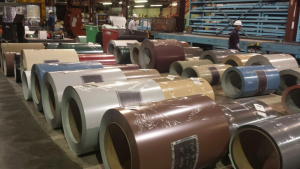 Most consumers do frankly not understand the differences between paint systems and sadly can be easily misled. Especially as, when brand new, panels with different paint system look pretty much identical.
Most consumers do frankly not understand the differences between paint systems and sadly can be easily misled. Especially as, when brand new, panels with different paint system look pretty much identical.
Often this lack of understanding applies also to builders and suppliers, who should be doing the teaching in the first place. In talking with the future building owner, a builder or supplier might have the advantage of selling SMP (Silicone-Modified Polyester) against a lower price (and lesser quality) Polyester.
There are always consumers who are looking for the cheapest possible products – regardless of quality. These are the same folks who buy second hand shoes at thrift stores. I believe far more people want their hard-earned money spent on their new pole building to get them a building which will look good for the long term.
Polyesters are the “low end” of the three primary resins used for coating exterior metal products. They offer a hard, scratch-resistant finish and a wide range of gloss, but are prone to chalking when exposed to UV (ultra violet) rays. Polyesters have been greatly improved since their introduction in the 1960s, however, with higher molecular weights and longer polymeric chains which create stronger, more UV-resistant bonds.
Polyester paint systems have improved greatly over the years, but they remain the lowest tier for price and performance for coil-coated exterior metal. Scratch resistance is their strong suit. In years past polyesters were recommended for soffit, entry doors and other applications without full sun exposure. Modern polyesters can take sun better, but will never match the performance of PVDFs (Polyvinylidene Fluorides) or quality SMPs.
Polyesters generally offer a broader color spectrum than PVDFs, but the brighter and darker colors, especially reds and blues, are most prone to fade. Their tendency to chalk ranges from fair to poor.
Despite long-term fade, chalk and gloss issues, when formulated with stable pigments in light colors, polyesters offer a versatile and inexpensive coating which can look good for 10 years or more. Modern systems carry 10- or 15-year film integrity warranties, and boast of decent weathering performance results






